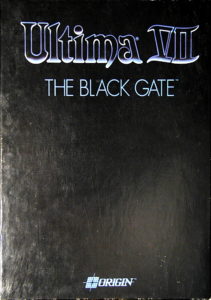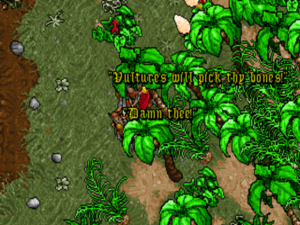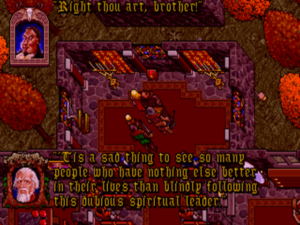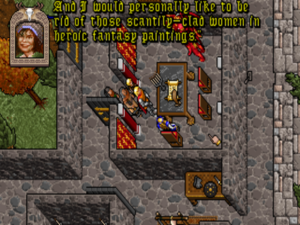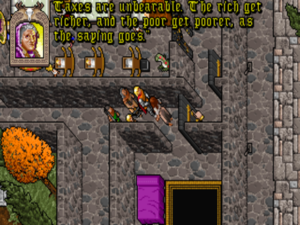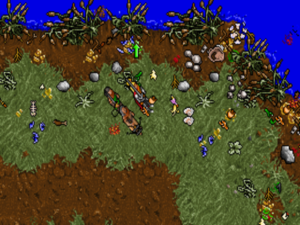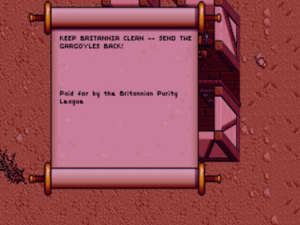From the time that Richard and Robert Garriott first founded Origin Systems in order to publish Ultima III, the completion of one Ultima game was followed almost immediately by the beginning of work on the next. Ultima VI in early 1990 was no exception; there was time only for a wrap party and a couple of weeks of decompression before work started on Ultima VII. The latter project continued even as separate teams made the two rather delightful Worlds of Ultima spinoffs using the old Ultima VI engine, and even as another Origin game called Wing Commander sold far more copies than any previous Ultima, spawning an extremely lucrative new franchise that for the first time ever made Origin into something other than The House That Ultima Built.
But whatever the source, money was always welcome. The new rival for the affections of Origin’s fans and investors gave Richard Garriott more of it to play with than ever before, and his ambitions for his latest Ultima were elevated to match. One of the series’s core ethos had always been that of continual technological improvement. Garriott had long considered it a point of pride to never use the same engine twice (a position he had budged from only reluctantly when he allowed the Worlds of Ultima spinoffs to be made). Thus it came as no surprise that he wanted to push things forward yet again with Ultima VII. Even in light of the series’s tradition, however, this was soon shaping up to be an unusually ambitious installment — indeed, by far the most ambitious technological leap that the series had made to date.
As I noted in my article on that game, the Ultima VI engine was, at least when seen retrospectively, a not entirely comfortable halfway point between the old “alphabet soup” keyboard-based interface of the first five games and a new approach which fully embraced the mouse and other modern computing affordances. Traces of the old were still to be found scattered everywhere amidst the new, and using the interface effectively meant constantly switching between keyboard-centric and mouse-centric paradigms for different tasks. Ultima VII would end such equivocation, shedding all traces of the interfaces of yore.
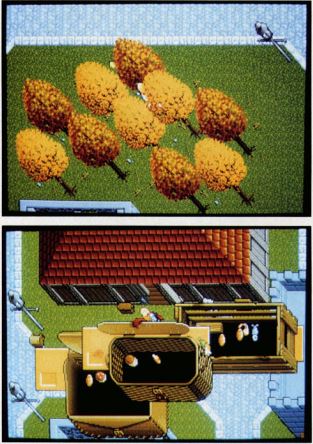
These screenshots from a Computer Gaming World preview of the game provide an interesting snapshot of Ultima VII in a formative state. The graphics are less refined than the final version, but the pop-up interface and the graphical containment model — more on that fraught subject later — are in place.
For the first time since Richard Garriott had discovered the magic of tile graphics in his dorm room at the University of Texas, the world of this latest Ultima was not to be built using that technique; Origin opted instead for a free-scrolling world shown from an overhead perspective, canted just slightly to convey the impression of depth. Gone along with the discrete tiles were the discrete turns of the previous Ultima games, replaced by true real-time gameplay. The world model included height — 16 possible levels of it! — as well as the other dimensions; characters could climb stairs to other floors in a building or walk up a hillside outdoors while remaining in the same contiguous space. In a move that must strike anyone familiar with the games of today as almost eerily prescient, Origin excised any trace of static onscreen interface elements. Instead the entire screen was given over to a glorious view of Britannia, with the interface popping up over this backdrop as needed. The whole production was designed with the mouse in mind first and foremost. Do you want your character to pick up a sword? Click on him to bring up his paper-doll inventory display, then drag the sword with the mouse right out of the world and into his hand. All of the things that the Ultima VI engine seemed like it ought to be able to do, but which proved far more awkward than anticipated, the Ultima VII engine did elegantly and effortlessly.
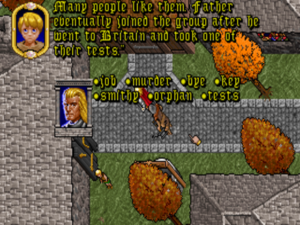
Looking for a way to reduce onscreen clutter and to show as much of the world of Britannia as possible at one time, Origin realized they could pop up interface elements only when needed. This innovation, seldom seen before, has become ubiquitous in the games — and, indeed, in the software in general — of today.
Origin had now fully embraced a Hollywood-style approach to game production, marked by specialists working within strictly defined roles, and the team which built Ultima VII reflected this. Even the artists were specialized. Glen Johnson, a former comic-book illustrator, was responsible for the characters and monsters as they appeared in the world. Michael Pierce was the resident portrait artist, responsible for the closeups of faces that appeared whenever the player talked to someone. The most specialized artistic role of all belonged to Bob Cook, a landscape artist hired to keep the multi-level environment coherent and proportional.
Of course, there were plenty of programmers as well, and they had their work cut out for them. Bringing Garriott’s latest Ultima to life would require pushing the latest hardware right to the edge and, in some situations, beyond it. Perhaps the best example of the programmers’ determination to find a way at all costs is their Voodoo memory manager. Frustrated with MS-DOS’s 640 K memory barrier and unhappy with all of the solutions for getting around it, the programming team rolled up their sleeves and coded a solution of their own from scratch. It would force virtually everyone who played the game at its release to boot their machines from a custom floppy, and would give later users even more headaches; in fact, it would render the game unplayable on many post-early-1990s machines, until the advent of software emulation layers like DOSBox. Yet it was the only way the programming team could make the game work at all in 1992.
As usual for an Ultima, the story and structure of play evolved only slowly, after the strengths and limitations of the technology that would need to enable them were becoming clear. Richard Garriott began with one overriding determination: he wanted a real bad guy this time, not just someone who was misguided or misunderstood: “We wanted a bad guy who was really evil, truly, truly evil.” He envisioned an antagonist for the Avatar cut from the classic cloth of novelistic and cinematic villains, one who could stick around for at least the next few games. Thus was born the disembodied spirit of evil known as the Guardian, who would indeed proceed to dog the Avatar’s footsteps all the way through Ultima IX. One might be tempted to view this seeming return to a black-versus-white conception of morality as a step back for the series thematically. But, as Garriott was apparently aware, the moral plot twists of the previous two games risked becoming a cliché in themselves if perpetuated indefinitely.
Then too, while Ultima VII would present a story carrying less obvious thematic baggage than the last games, that story would be executed far more capably than any of those others. For, as the most welcome byproduct of the new focus on specialization, Origin finally hired a real writing team.

Raymond Benson and Richard Garriott take the stage together for an Austin theatrical fundraiser with a Valentines Day theme. Benson played his “love theme” from Ultima VII while Garriott recited “The Song of Solomon” — with tongue planted firmly in cheek, of course.
The new head writer, destined to make a profound impact on the game, was an intriguingly multi-talented fellow named Raymond Benson. Born in 1955, he was a native of Origin’s hometown of Austin, Texas, but had spent the last decade or so in New York City, writing, directing, and composing music for stage productions. As a sort of sideline, he’d also dabbled in games, writing an adventure for the James Bond 007 tabletop RPG and writing three text-adventure adaptations of popular novels during the brief mid-1980s heyday of bookware: The Mist, A View to a Kill, and Goldfinger. Now, he and his wife had recently started a family, and were tired of their cramped Manhattan flat and the cutthroat New York theater scene. When they saw an advertisement from Origin in an Austin newspaper, seeking “artists, musicians, and programmers,” Benson decided to apply. He was hired to be none of those things — although he would contribute some of his original music to Ultima VII — but rather to be a writer.
When he crossed paths with the rest of Origin Systems, Benson was both coming from and going to very different places than the majority of the staff there, and his year-long sojourn with them proved just a little uncomfortable. Benson:
It was like working in the boys’ dormitory. I was older than most of the employees, who were 95 percent male. In fact, I believe less than ten out of fifty or sixty employees were over thirty, and I was one of them. So, I kind of felt like the old fart a lot of times. Most of the employees were young single guys, and it didn’t matter to them if they stayed at the office all night, had barbecues at midnight, and slept in a sleeping bag until noon. Because I had a family, I needed to keep fairly regular 8-to-5 hours, which is pretty impossible at a games company.
A snapshot of the cultural gulf between Benson and the average Origin employee is provided by an article in the company’s in-house newsletter entitled “What Influences Us?” Amidst lists of “favorite fantasy/science fiction films” and “favorite action/adventure films,” Benson chooses his “ten favorite novels,” unspooling an eclectic list that ranges from Dracula to The Catcher in the Rye, Lucky Jim to Maia — no J.R.R. Tolkien or Robert Heinlein in sight!

Some of the references in Ultima VII feel like they just had to have come directly from the slightly older, more culturally sophisticated diversified mind of Raymond Benson. Here, for instance, is a riff on Black Like Me, John Howard Griffin’s landmark work of first-person journalism about racial prejudice in the United States.
It’s precisely because of his different background and interests that Benson’s contribution to Ultima VII became so important. Most of the writing in the game was actually dialog, and deft characterization through dialog was something his theatrical background had left him well-prepared to tackle. Working with and gently coaching a team consisting of four other, less experienced writers, he turned Richard Garriott’s vague story outline, about the evil Guardian and his attempt to seize control of Britannia through a seemingly benign religious movement known as the Fellowship, into the best-written Ultima ever. The indelible Ultima tradition of flagrantly misused “thees” and “thous” aside, the writing in Ultima VII never grates, and frequently sparkles. Few games since the heyday of Infocom could equal it. Considering that Ultima VII alone quite possibly has as much text as every Infocom game combined, that’s a major achievement.
The huge contributions made by Raymond Benson and the rest of the writing team — not to mention so many other artists, programmers, and environment designers — do raise the philosophical question of how much Ultima VII can still be considered a Richard Garriott game, full stop. From the time that his brother Robert convinced him that he simply couldn’t create Ultima V all by himself, as he had all of his games up to that point, Richard’s involvement with the nitty-gritty details of their development had become steadily less. By the early 1990s, we can perhaps already begin to see some signs of the checkered post-Origin career in game development that awaited him — the career of a basically good-natured guy with heaps of money, an awful lot of extracurricular interests, and a resultant short attention span. He was happy to throw out Big Ideas to set the direction of development, and he clearly still relished demonstrating Origin’s latest products and playing Lord British, but his days of fussing too much over the details were, it seems, already behind him by the time of Ultima VII. Given a choice between sitting down to make a computer game or throwing one of his signature birthday bashes or Halloween spook houses — or, for that matter, merely playing the wealthy young gentleman-about-town in Austin high society more generally — one suspects that Garriott would opt for one of the latter every time.
Which isn’t to say that his softer skill set wasn’t welcome in a company in transition, in which tensions between the creative staff and management were starting to become noticeable. For the people on the front line actually making Ultima VII, working ridiculous hours under intense pressure for shockingly little pay, Garriott’s talents meant much indeed. He would swoop in from time to time to have lunch catered in from one of Austin’s most expensive restaurants. Or he would tell everyone to take the afternoon off because they were all going out to the park to eat barbecue and toss Frisbees around. And of course they were always all invited to those big parties he loved to throw.
Still, the tensions remained, and shouldn’t be overlooked. Lurking around the edges of management’s attitude toward their employees was the knowledge that Origin was the only significant game developer in Austin, a fast-growing, prosperous city with a lot of eager young talent. Indeed, prior to the rise of id Software up in Dallas, they had no real rival in all of Texas. Brian Martin, a scripter on Ultima VII, remembers being told that “people were standing in line for our jobs, and if we didn’t like the way things were, we could just leave.” Artist Glen Johnson had lived in Austin at the time Origin hired him to work in their New Hampshire office, only to move him back to Austin once again when that office was closed; he liked to joke that the company had spent more money on his plane fare during his first year than on his salary.
The yin to Richard Garriott’s yang inside Origin was Dallas Snell, the company’s hard-driving production manager, who was definitely not the touchy-feely type. An Origin employee named Sheri Graner Ray recounts her first encounter with him:
My interviews at Origin Systems culminated with an interview with Dallas Snell. He didn’t turn away from his computer, but sort of waved a hand in the general direction of a chair. I hesitantly took a seat. Dallas continued to type for what seemed to me to be two or three hours. Finally, he stopped, swung around in his desk chair, leaned forward, put one hand on his knee and the other on his hip, narrowed his eyes at me, and said, “You’re here for me to decide if I LIKE you.” I was TERRIFIED. Well, I guess he did, cuz I got the job, but I spent the next year ducking and avoiding him, as I figured if he ever decided he DIDN’T like me, I was in trouble!
Snell’s talk could make Origin’s games sound like something dismayingly close to sausages rolling down a production line. He was most proud of Wing Commander and Savage Empire, he said, because “these projects were done in twelve calendar months or less, as compared to the twenty-to-thirty-month time frame that previous projects were developed in!” Martian Dreams filled six megabytes on disk, yet was done in “seven calendar months!!! Totally unprecedented!!” Wing Commander II filled 15 megabytes, yet “the entire project will have been developed in eight calendar months!!!” He concluded that “no one, absolutely no one, has done what we have, or what we are yet still capable of!!! Not Lucasfilm, not Sierra, not MicroProse, not Electronic Arts, not anyone!” The unspoken question was, at what cost to Origin’s staff?
It would be unfair to label Origin Systems, much less Dallas Snell alone, the inventor of the games industry’s crunch-time culture and its unattractive byproduct and enabler, the reliance on an endless churn of cheap young labor willing to let themselves be exploited for the privilege of making games. Certainly similar situations were beginning to arise at other major studios in the early 1990s. And it’s also true that the employees of Origin and those other studios were hardly the first ones to work long hours for little pay making games. Yet there was, I think, a qualitative difference at play. The games of the 1980s had mostly been made by very small teams with little hierarchy, where everyone could play a big creative role and feel a degree of creative ownership of the end product. By the early 1990s, though, the teams were growing in size; over the course of 1991 alone, Origin’s total technical and creative staff grew from 40 to 120 people. Thus companies like Origin were instituting — necessarily, given the number of people involved — more rigid tiers of roles and specialties. In time, this would lead to the cliché of the young 3D modeller working 100-hour weeks making trees, with no idea of where they would go in the finished game and no way to even find out, much less influence the creative direction of the final product in any more holistic sense. For such cogs in the machine, getting to actually make games (!) would prove rather less magical than expected.
Origin was still a long way from that point, but I fancy that the roots of the oft-dehumanizing culture of modern AAA game production can be seen here. Management’s occasional attempts to address the issue also ring eerily familiar. In the midst of Ultima VII, Dallas Snell announced that “the 24-hour work cycle has outlived its productivity”: “All employees are required to start the day by 10:00 AM and call it a day by midnight. The lounge is being returned to its former glory (as a lounge, that is, without beds).” Needless to say, the initiative didn’t last, conflicting as it did with the pressing financial need to get the game done and on the market.
Simply put, Ultima VII was expensive — undoubtedly the most expensive game Origin had ever made, and quite possibly the most expensive computer game anyone had yet made. Just after its release, Richard Garriott claimed that it had cost $1 million to make, the first time to my knowledge that that milestone figure was associated with any game. Of course, the number is comically low by modern standards, even when adjusted for inflation — but this was a time when a major hit might only sell 100,000 units rather than the 10 million or so of today.
Origin had first planned to release Ultima VII in time for the Christmas of 1991, an impossibly optimistic time frame (impossibly optimistic time frames being another trait which the Origin of the early 1990s shares with many game studios of today). When it became clear that no amount of crunch would allow the team to meet that deadline, the pressure to get it out as soon as possible after Christmas only increased. Looking over their accounts at year’s end, Origin realized that 90 percent of their revenue in 1991 had come through the Wing Commander franchise; had Wing Commander II not become as huge a hit as the first installment, they would have been bankrupt. This subsidizing of Ultima with Wing Commander was an uncomfortable place to be, and not just for the impact it might have had on Lord British’s (alter) ego. It meant that, with no major Wing Commander releases due in 1992, an under-performing Ultima VII could take down the whole company. Many at Origin were surprisingly clear-eyed about the dangers which beset them. Mike McShaffry, a programmer and unusually diligent student of the company’s financial situation among the rank and file — unsurprisingly, he would later become an entrepreneur himself — expressed his concern: “The road ahead for us is a bumpy one. Many companies do not survive the ‘boom town’ growth phase that we have just experienced.”
Thus when Ultima VII: The Black Gate — the subtitle was an unusually important one, given that Origin had already authorized a confusingly titled Ultima VII Part Two using the same game engine — shipped on April 16, 1992, the whole company’s future was riding on it.
Classic games, it seems to me, can be plotted on a continuum between two archetypes. At one pole are the games which do everything right — those whose designers, faced with a multitude of small and large choices, have made the right choice every time. Ultima Underworld, the spinoff game which Origin released just two weeks before Ultima VII, is one of these.
The other archetypal classic game is much rarer: the game whose designers have made a lot of really problematic choices, to the point that certain parts of it may be flat-out broken, but which nevertheless charms and delights due to some ineffable spirit that overshadows everything else. Ultima VII is the finest example of this type that I can think of. Its list of trouble spots is longer than that of many genuinely bad games, and yet its special qualities are so special that I can only recommend that you play it.
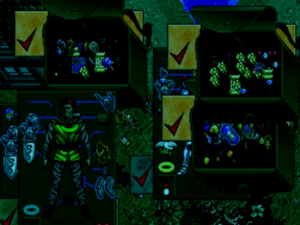
Inventory management in Ultima VII. It’s really, really hard to find anything, especially in the dark. Of course, I could fire up a torch… but wait! My torches are buried somewhere under all that mess in my pack.
Any list of that which is confusing, infuriating, or just plain boring in Ultima VII must start with the inventory-management system. The drag-and-drop approach to same is brilliant in conception, but profoundly flawed in execution. You need to cart a lot of stuff around in this game — not just weapons and armor and quest items and money and loot, but also dozens of pieces of food to keep your insatiable characters fed on their journeys and dozens or hundreds of magic reagents to let you cast spells. All of this is lumped together in your characters’ packs as an indeterminate splodge of overlapping icons. Unless you formulate a detailed scheme of exactly what should go where and stick to it with the rigidity of a pedant, you’ll sometimes find it impossible to figure out what you actually have and where it is on your characters’ persons. When that happens, you’ll have to resort to finding a clear spot of ground and laying out the contents of each pack on it one by one, looking for that special little whatsit.
Keys belong to their own unique circle of Inventory Hell. Just a few pixels big, they have a particular tendency to get hopelessly lost at the bottom of your pack along with those leftover leeks you picked up for some reason in the bar last night. Further, keys are distinguished only by their style and color — the game does nothing so friendly as tell you what door a given key opens, even after you’ve successfully used it — and there are a lot of them. So, you never feel quite confident when you can’t open a door that you haven’t just overlooked the key somewhere in the swirling chaos vortex that is your inventory. If you really love packing your suitcase before a big trip, you might enjoy Ultima VII‘s inventory management. Otherwise, you’ll find it to be a nightmare.
The combat system is almost as bad. Clearly Origin, to put it as kindly as possible, struggled to adapt combat to the real-time paradigm. While you can assemble a party of up to eight people, you can only directly control the Avatar himself in combat, and that only under a fairly generous definition of “control.” You click a button telling your people to start fighting, whereupon everyone, friend and foe alike, converges upon the same pixel as occasional words — “Aargh!,” “To arms!,” “Vultures will pick thy bones!” — float out of the scrum. The effect is a bit like those old Warner Bros. cartoons where Wile E. Coyote and the Road Runner disappear into a cloud of arms and legs until one of them pops out victorious a few seconds later.
The one way to change this dynamic also happens to be the worst possible thing you can do: equipping your characters with ranged weapons. This will cause them to open fire indiscriminately in the vague direction of the aforementioned pixel of convergence, happily riddling any foes and friends alike who happen to be in the way full of arrows. In light of this, one can only be happy that the Avatar is the only one allowed to use magic; the thought of this lot of nincompoops armed with fireballs and magic missiles is downright terrifying. Theoretically, it’s possible to control combat to some degree by choosing from several abstract strategies for each character, and to directly intervene with the Avatar by clicking specific targets, but in practice none of it makes much difference. By the time some of your characters start deciding to throw down all their weapons and hide in a corner for no apparent reason, you just shrug and accept it; it’s as explicable as anything else here.
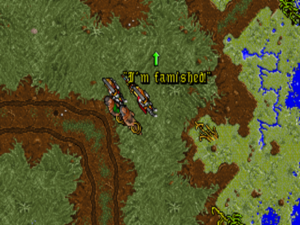
You’ll learn to dread your party’s constant mewling for food, not least because it forces you to engage with the dreadful inventory system. (No, they can’t feed themselves. You have to hand-feed each one of them like a little birdie.)
Thankfully, nothing else in the game is quite as bad as these two aspects, but there are other niggling annoyances. The need to manually feed your characters is prominent among them. There’s no interest or challenge to collecting food. Even if you aren’t willing to blatantly steal it from every building you visit — something for which, unlike in Ultima IV, there are no consequences — there are lots of infallible but tedious means of collecting money to buy it. (Determined to be a good Avatar, I spent literally hours when I played the game marching back and forth from one end of the town of Britain to the other, buying meat cheap and selling it expensive, all so as to buy yet more meat to feet my hungry lot.) The need for food serves only to extend the length of a game that doesn’t need to be extended, and to do it in the most boring way possible.
But then, this sort of thing had always been par for the course with any Ultima, a series that always tended to leaven its inspired elements with a solid helping of tedium. And then too, Ultima had always been a little wonky when it came to its mechanics; Richard Garriott ceded that ground to Wizardry back in the days of Ultima I, and never really tried to regain it. Still, it’s amazing how poorly Ultima VII, a game frequently praised as one of the best CRPGs ever made, does as a CRPG, at least as most people thought of the genre circa 1992. Because there’s no interest or pleasure in combat, there’s no thrill to leveling up or collecting new weapons and armor. You have little opportunity to shape your characters’ development in any way, and those sops to character management that are present, such as the food system, merely annoy. Dungeons — many or most of them optional — are scattered around, but they’re fairly small while still managing to be confusing; the free-scrolling movement makes them almost impossible to map accurately on paper, yet the game lacks an auto-map. If you see a CRPG as a game in the most traditional sense of the word — as an intricate system of rules to learn and to manipulate to your advantage — you’ll hate, hate, hate Ultima VII for its careless mechanics. One might say that it’s at its worst when it actively tries to be a CRPG, at its best when it’s content to be a sort of Britannian walking simulator.
And yet I don’t dislike the game as much as all of the above might imply. In fact, Ultima VII is my third favorite game to bear the Ultima name, behind only Martian Dreams and the first Ultima Underworld. The reason comes down to how compelling the aforementioned walking simulator actually manages to be.
I’ve never cared much one way or the other about Britannia as a setting, but darned if Ultima VII doesn’t shed a whole new light on the place. At its best, playing this game is… pleasant, a word not used much in regard to ludic aesthetics, but one that perhaps ought to crop up more frequently. The graphics are colorful, the music lovely, the company you keep more often than not charming. It’s disarmingly engaging just to wander around and talk to people.
Underneath the pleasantness, not so much undercutting it is as giving it more texture, is a note of melancholy. This adventure in Britannia takes place many years after the Avatar’s previous ones, and the old companions in adventure who make up his party are as enthusiastic as ever, but also a little grayer, a little more stooped. Meanwhile other old friends (and enemies) from the previous games are forever waiting in the wings for one last cameo. If a Britannia scoffer like me can feel a certain poignancy, it must be that much more pronounced for those who are more invested in the setting. Today, the valedictory feel to Ultima VII is that much affecting because we know for sure that this is indeed the end of the line for the classic incarnation of Britannia. The single-player series wouldn’t return there until Ultima IX, and that unloved game would alter the place’s personality almost beyond recognition. Ah, well… it’s hard to imagine a lovelier, more affectionate sendoff for old-school Britannia than the one it gets here.
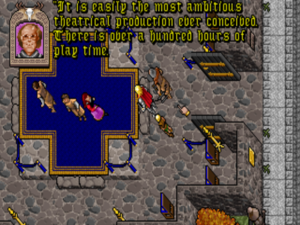
The writing team loves to flirt with the fourth wall. Fortunately, they never quite take it to the point of undermining the rest of the fiction.
Yet even as the game pays loving tribute to the Britannia of yore, there’s an aesthetic sophistication about it that belies the series’s teenage-dungeonmaster roots. It starts with the box, which, apart from the title, is a foreboding solid black. The very simplicity screams major statement, like the Beatles’ White Album or Prince’s Black Album. Certainly it’s a long way from the heaving bosoms and fire-breathing dragons of the typical CRPG cover art.
When you start the game, you’re first greeted with a title screen that evokes the iconic opening sequence to Ultima IV, all bright spring colors and music that smacks of Vivaldi. But then, in the first of many toyings with the fourth wall, the scene dissolves into static, to be replaced by the figure of the Guardian speaking directly to you.
As you wander through Britannia in the game proper, the Guardian will continue to speak to you from time to time — the only voice acting in the game. His ominous presence is constantly jarring you when you least expect it.
The video snippet below of a play within the play, as it were, that you encounter early in the game illustrates some more of the depth and nuance of Ultima VII‘s writing. (Needless to say, this scene in particular owes much to Raymond Benson’s theatrical background.)
This sequences offers a rather extraordinary layer cake of meanings, making it the equal of a sophisticated stage or film production. We have the deliberately, banally bad play put on by the Fellowship actors, with its “moon, June, spoon” rhyme sequences. Yet peaking through the banality, making it feel sinister rather than just inept, is a hint of cult-like menace. Meanwhile the asides of our companions tell us not only that the writers know the play is bad, but that said companions are smart enough to recognize it as well. We have Iolo’s witty near-breaking of the fourth wall with his comment about “visual effects.” And then we have Spark’s final verdict on the passion play, delivered as only a teenager can: “This is terrible!” (For some reason, that line makes me laugh every time.) No other game of 1992, with the possible exception only of the text adventure Shades of Gray, wove so many variegated threads of understanding into its writing. Nor is the scene above singular. The writing frequently displays the same wit and sophistication as what you see above. This is writing by and for adults.
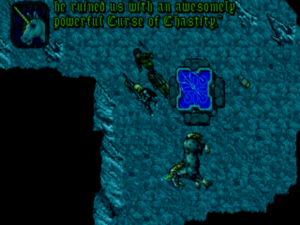
The description of Ultima VII‘s writing as more adult than the norm also applies in the way in which the videogame industry typically uses that adjective. There’s a great extended riff on the old myths of unicorns and virgins. The conversation with a horny unicorn devolves into speculation about whether the Avatar himself is, shall we say, fit to ride the beast…
For all of the cutting-edge programming that went into the game, it really is the writing that does the bulk of the heavy lifting in Ultima VII. And it’s here that this first million-dollar computer game stands out most from the many big-budget productions that would follow it. Origin poured a huge percentage of that budget not into graphics or sound but into content in its purest form. If not the broadest world yet created for a computer at the time of the game’s release, this incarnation of Britannia must be the deepest and most varied. Nothing here is rote; every character has a personality, every character has something all her own to say. The sheer scale of the project which Raymond Benson’s team tackled — this game definitely has more words in it than any computer game before it — is well-nigh flabbergasting.
Further, the writers have more on their minds than escapist fantasy. They use the setting of Britannia to ponder the allure of religious cults, the social divide between rich and poor, and even the representation of women in fantasy art, along with tax policy, environmental issues, and racism. The game is never preachy about such matters, but seamlessly works its little nuggets for thought into the high-fantasy setting. Ultima VII may lack the overriding moral message that had defined its three predecessors, but that doesn’t mean it has nothing to say. Indeed, given the newfound nuance and depth of the writing, the series suddenly has more to say here than ever before.
Because of how much else there is to see and do, the main plot about the Guardian sometimes threatens to get forgotten entirely. But it’s enjoyable enough as such things go, even if its main purpose often does seem to be simply to give you a reason to wander around talking to people. In the second half of the game, the plot picks up steam, and there are a fair number of traditional CRPG-style quests to complete. (There are also more personal “quests” among the populaces of the towns you visit, but they’re largely optional and hardly earth-shattering. They are, however, often disarmingly sweet-natured: getting the shy lovelorn fellow together with the girl he worships from afar… that sort of thing.) The game as a whole is very soluble as long as you take notes when you’re given important information; there’s no trace of a quest log here.
While a vocal minority of Ultima fandom decries this seventh installment for the perfectly justifiable reasons I mentioned earlier in this article, the majority laud it as — forgive the inevitable pun! — the ultimate incarnation of what Richard Garriott began working toward in the late 1970s. Even with all of its annoying aspects, it’s undoubtedly the most accessible Ultima for the modern player, what with its fairly intuitive mouse-driven interface, its reasonably attractive graphics and sound, and its relatively straightforward and fair main quest. Meanwhile its nuanced writing and general aesthetic sophistication are unrivaled by any earlier game in the series. If it’s not the most historically important of the main-line Ultima games — that honor must still go to the thematically groundbreaking Ultima IV — it’s undoubtedly the one most likely to be enjoyed by a player today.
Indeed, it’s been called the blueprint for many of the most popular epic CRPGs of today — games where you also spend much of your time just walking around and talking to a host of more or less interesting characters. That influence can easily be overstated, but that doesn’t mean there isn’t something to the claim. No other CRPG in 1992, or for some thereafter, played quite like this one, and Ultima VII really does have at least as much in common with the CRPGs of today as it does with its contemporaries. On the whole, then, its hallowed modern reputation is well-earned.

Richard Garriott (far left) and the rest of the Ultima VII team toast the game’s release at Britannia Manor, the former’s Austin mansion.
Its reception in 1992, on the other hand, was far more mixed than that reputation might suggest. Questbusters magazine, deploying an unusually erudite literary comparison of the type of which Raymond Benson might have approved, called it “the Finnegans Wake of computer gaming — a flawed masterpiece,” referring to its lumpy mixture of the compelling and the tedious. Computer Gaming World‘s longtime adventure reviewer Scorpia had little good at all to say about it. Perhaps in response to her negativity, the same magazine ran a second, much more positive review from Charles Ardai in the next issue. Nevertheless, he began by summing up the sense of ennui that was starting to surround the whole series for many gamers: “Many who were delighted when Ultima VI was released can’t be bothered to boot up Ultima VII, as though it goes without saying that the seventh of anything can’t possibly be any good. The market suddenly seems saturated; weary gamers, sure that they have played enough Ultima to last a lifetime, eye the new Ultima with suspicion that it is just More Of The Same.” Even at the end of his own positive review, written with the self-stated goal of debunking that judgment, Ardai deployed a counter-intuitive closing sentiment: “After seven Ultimas, it might be time for Lord British to turn his sights elsewhere.”
Not helping the game’s reception were all of the technical problems. It’s all too easy to forget today just how expensive it was to be a computer gamer in the early 1990s, when the rapid advancement of technology meant that you had to buy a whole new computer every couple of years — or less! — just to be able to play the latest releases. More so even that its contemporaries, Ultima VII pushed the state of the art in hardware to its limit, meaning that anyone lagging even slightly behind the bleeding edge got to enjoy constant disk access, intermittent freezes of seconds at a time, and the occasional outright crash.
And then there were the bugs, which were colorful and plentiful. Chunks of the scenery seemed to randomly disappear — including the walls around the starting town of Trinsic, thus bypassing the manual-lookup scheme Origin had implemented for copy protection. A plot-critical murder scene in another town simply never appeared for some players. Even worse, a door in the very last dungeon refused to open for some; Origin resorted to asking those affected to send their save file on floppy disk to their offices, to be manually edited in order to correct the problem and sent back to them. But by far the most insidious bug — one from which even the current edition of the game on digital-download services may not be entirely free — were the keys that disappeared from player’s inventories for no apparent reason. Given what a nightmare keeping track of keys was already, this felt like the perfect capstone to a tower of terribleness. (One can imagine the calls to Origin’s customer support: “Now, did you take all of the stuff out of all of your packs and sort it out carefully on the ground to make sure your key is really missing? What about those weeks-old leeks down there at the bottom of your pack? Did you look under them?”) Gamers had good cause to be annoyed at a product so obviously released before its time, especially in light of its astronomical $80 suggested retail price.
A Computer Gaming World readers’ poll published in the March 1993 issue — i.e., exactly one year after Ultima VII‘s release — saw it ranked as the respondents’ 30th favorite current game, not exactly a spectacular showing for such a major title. Wing Commander II, by way of comparison, was still in position six, Ultima Underworld — which was now outselling Ultima VII by a considerable margin — in a tie for third. It would be incorrect to call Ultima VII a flop, or to imply that it wasn’t thoroughly enjoyed by many of those who played it back in the day. But for Origin the facts remained when all was said and done that it had sold less well than either of the aforementioned two games after costing at least twice as much to make. These hard facts contributed to the feeling inside the company that, if it wasn’t time to follow Charles Ardai’s advice and let sleeping Ultimas lie for a while, it was time to change up the formula in a major way. After all, Ultima Underworld had done just that, and look how well that had worked out.
But that discussion, of course, belongs to history. In our own times, Ultima VII remains an inspiring if occasionally infuriating experience well worth having, even if you don’t normally play CRPGs or couldn’t care less about the lore of Britannia. I can only encourage all of you who haven’t played it before to remedy that while you wait for my next (and last) article about the game, which will look more closely at the Fellowship, a Britannian cult with an obvious Earthly analogue.
(Sources: the book Ultima: The Avatar Adventures by Rusel DeMaria and Caroline Spector; Origin Systems’s internal newsletter Point of Origin dated August 7 1991, October 25 1991, December 20 1991, February 14 1992, February 28 1992, March 13 1992, April 20 1992, and May 22 1992; Questbusters of July 1991 and August 1992; Computer Gaming World of April 1991, October 1991, August 1992, September 1992, and March 1993; Compute! of January 1992; online sources include The Ultima Codex interviews with Raymond Benson and Brian Martin, a vintage Usenet interview with Richard Garriott, and Sheri Graner Ray’s recollections of her time at Origin on her blog.
Ultima VII: The Black Gate is available for purchase on GOG.com. You may wish to play it using Exult instead of the original executable. The former is a free re-implementation of the Ultima VII engine which fixes some of its worst annoyances and is friendly with modern computers.)
Original URL: https://www.filfre.net/2019/02/ultima-vii/

